Why, When And How To Exit A Trade
One evening, while
giving a trading seminar in the Los Angeles area, I was approached by
an attendee who asked me why TradingMarkets.com had many articles on patterns
and strategies,
but none on how to get
out of a trade, and few on trade
management.
I thought his question brought up a
very salient point. Go into any bookstore and you can find a multitude of books
concerning methodology, systems and theories on how to trade — particularly how
to spot a setup and nail down an entry point. You will be lucky to find enough
books on trade management to make up a stack that would get much higher than
your shin.
Part of this is for good reason: Each
trade is unique and must be managed by the trader himself or herself. This is an
area of trading, however, that is neglected in education, and is worthy of
looking at in greater detail. While this article will not give you hard-and-fast
rules to follow, I will show you some things you should consider at important
inflection points within a trade, and possibly shed some light on how top
traders might manage some of the following.
The
Initial Protective Stop (IPS) — The Trader’s First Safety Net
Regardless of the setup, the most
important part of your entry is determining an Initial
Protective Stop (IPS). This will determine your maximum initial risk,
in the event the trade should go against you, and prevent a potentially small
loss from turning into a big one. How you place your IPS is up to you —
depending on the type of trader you are. It is reliant upon the time frame of
your trade, the size of your position, your account size, and the amount of risk
you are willing to assume. Most traders determine the placement of their IPS by
analyzing factors such as:
- Technical
Patterns: Many traders will
use technical levels like support, resistance, or previous highs or lows.
This method is used by many swing traders, as well as those who work on an
intraday basis. - Point-Based
Stops: These are most often used by
daytraders, and depending on the size of their initial position, may even be
as low as 1/2 or 1/4 point. - Volatility:
Dave Landry has written an excellent three-part series on determining an
instrument’s volatility and how to use it to determine appropriate stop
placement. You can access the first installment of the series by clicking
here. Volatility is an important factor to consider if you are going to
use point-based stops. - Position
Size: The size of the position will also affect how much risk you
will take, either making you set a tighter stop (with a greater likelihood
of being hit) on a larger number of shares, or using a looser stop (more
points being at risk) on a smaller position.

Burlington Resources
(
BR |
Quote |
Chart |
News |
PowerRating) is an example of a stop based on the technical pattern of the chart. A
swing trader after determining his entry point in this simple pullback pattern,
would most likely place the Initial Protective Stop one tick under the prior
day’s low. (Chart courtesy of Quote.com)
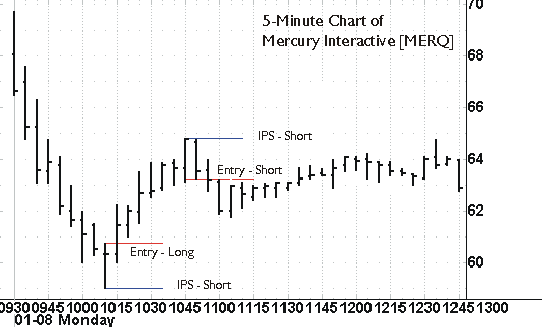
Daytraders who play
price swings on an intraday basis can also employ this technique. (Chart
courtesy of Quote.com)
Point-based stops, while
used mostly by daytraders, are used effectively by swing traders as well. In
using a point-based IPS as a swing trader, you must consider the volatility of
the equity or future you are trading as well as position size. For example, it
would not be a very successful strategy to risk 2 points on a swing trade (three-
to seven-day period) on an equity like SDL Inc.
(
SDLI |
Quote |
Chart |
News |
PowerRating) which has a
minimum daily range of 15 points and many times will rise or fall 30 points on
an intraday basis.
To successfully trade a volatile stock such as this, a more
prudent plan would be to use the average daily range to determine the amount of
points to risk, then determine the amount of your trading capital to venture
that will correlate to your protective stop. If you want to risk 2% of a $50,000
trading account = $1,000, have decided to place your IPS 10 points from your
entry and the stock is trading at $100 per share — your position size would be
100 shares (10 point possible loss X 100 shares = $1000).
Daytraders can get by
risking a tighter IPS (anywhere from 1 point to as little as 1/4 of a point)
since they usually go home flat and re-enter trades throughout the day with
greater frequency than swing traders do. Most successful daytraders who use
point-based stops for initial protection employ strategies that entail the
position to move in their favor immediately, or they are out in a short period
of time even if their stop has not been hit.
How To
Keep Profits In Your Account
Now you have found a
prime setup and determined how you are going to enter and where you are going to
place the Initial Protective Stop. The stock or futures contract make a nice
move in your favor. How do you now proceed? Where you go from here can be
determined by a few factors, but as a short-term or swing trader there is one
very important rule that you must adhere to if you are going to survive in the
trading jungle:
Never, under any
circumstances, allow a profit of 1 point or more to turn into a loss.
This is a must to
preserve your all important trading capital. There are different ways of doing
this, but the tenet of the rule is paramount. Anytime you have a profit of at
least 1 point, you must, at the very least, move your protective stop to the
level of your entry fill – guaranteeing at worst, a breakeven trade. Following
this simple rule will turn potential losers into scratched trades. You can
survive a great deal of breakeven trades (even allowing for commissions) much
longer than the same amount of losses.
Trailing
Stops
Trailing stops are used
by top traders to retain profits once a position has moved in their favor, be it
on an intraday or swing trading time frame. All you do is “trail” the
stock higher (or lower for shorts) as it moves in your favor. The simplest
trailing stop is to place the new stop one tick under the previous low, or one
tick above the prior high for short sales.
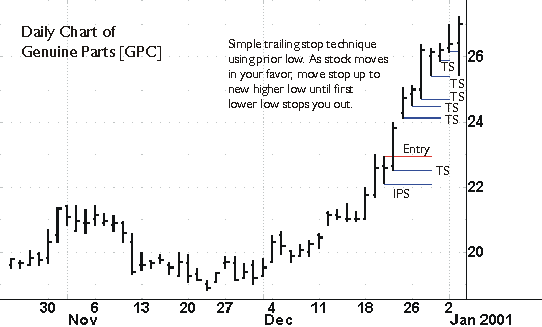
(Chart Courtesy of
Quote.com)
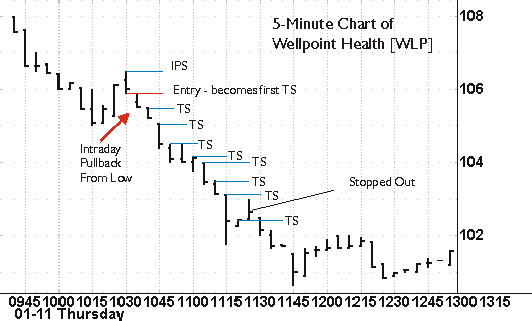
(Chart Courtesy of
Quote.com)
Two-For-One
Money Management
Practicing simple two for
one money management will make you look like a genius even it you don’t know
anything about rocket science or gas stoves. All that two for one money
management entails is that when your profit is double your initial risk, you
sell half of your position and raise your stop on your remaining shares to
breakeven. If the position continues to move in your favor, just keep trailing
the stop on the remaining shares. Nothin’ to it.
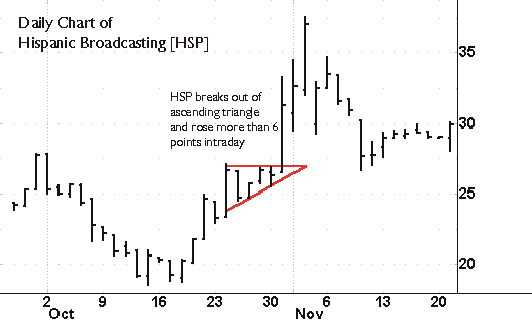
Here Hispanic
Broadcasting
(
HSP |
Quote |
Chart |
News |
PowerRating) broke out from an ascending triangle and rose more than 6
points intraday. By selling half the position, a trader will insure at worst a
breakeven trade. In this example, the trade continues higher before the trailing
stop is hit. (Chart Courtesy of Quote.com)
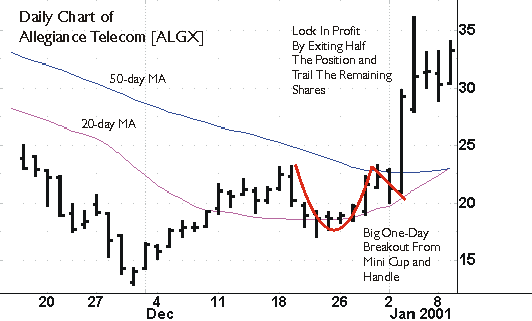
In the two examples
above, both trades turned out to be favorable. This will not always be the case.
Remember that top traders focus on a return of capital rather than a
return on capital. Winners will take care of themselves.
Scale-Out
Selling
One of the best parts of
my job is being able to work closely with the best traders in the world. Jeff
Cooper taught me a technique he uses to exit winning trades profitably. He takes
the two-for-one money management principle a step further, selling out of a
profitable intraday position in three pieces. He refers to this practice as
“scale-out selling.” If his position size is 3000 shares, he will exit
the first third of the position when he has doubled his initial 1 point risk and
move his stop on the remaining shares to his original fill price. If the stock
continues to move in his favor, he will sell the second 1000 shares of his
remaining position, and again move the stop to the level of his second sale. He
has now locked in 2 points of profit on the first third of his position, 4 or
more on the second and is sitting on the third piece with another 4 points of
gains being the worst-case scenario if the last stop is hit. Think for a moment
just how powerful a money-management technique this is — even on a 100-share lot
that the average trader is capitalized for:
-
First
piece – 2 points X 100 = $200 -
Second
portion – 4 points X 100 = $400 -
Remaining
shares – 4 points X 100 = $400 + ?
Granted, this is a best-case
example and is contingent on the trade being profitable on the outset, but even
if you just get to stage one, you have locked in 2 points on section one:
-
First
piece – 2 points X 100 = $200 -
Second
and third – Stop is hit at breakeven -
Profit
– $200
Would you take at least 2 points on
every trade? I know I would.
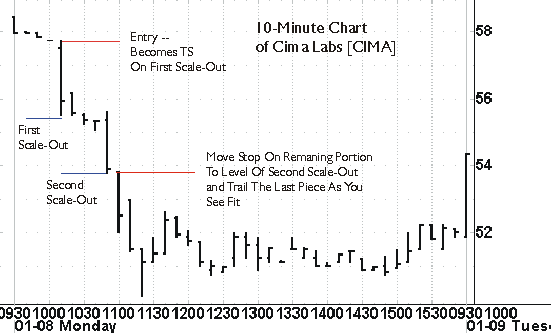
Conclusion
I have touched on some of the
techniques I use in my own trading and that I have learned from others. This is
far from complete with regards to utilizing stops and money management. Other
traders like Dave Landry, Mark Boucher and others have written other articles on
this subject in our Education
Section on what truly is the most important part of being a successful
trader. The greatest pattern or system discovered or yet to be is utterly
worthless without proper money
management.
For More On Money Management, Read TradingMarkets.com’s The Real Holy Grail
For The Best Trading
Books, Video Courses and Software To Improve Your Trading
